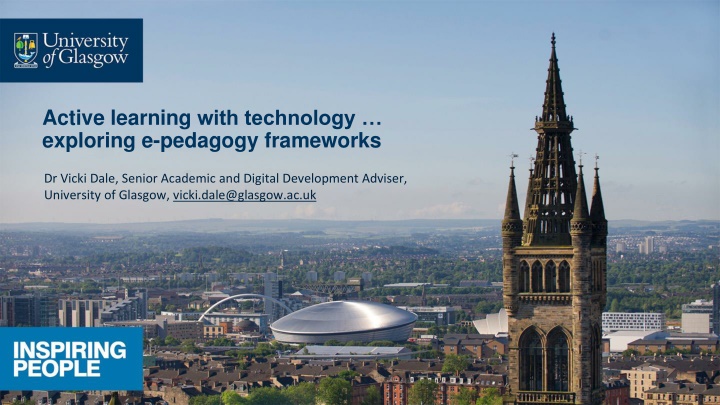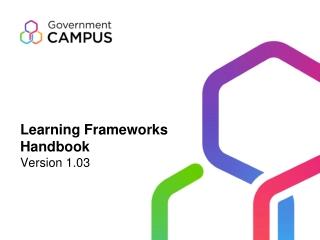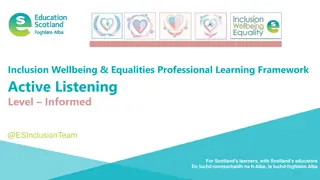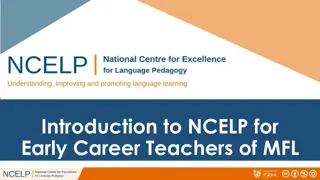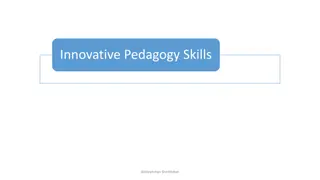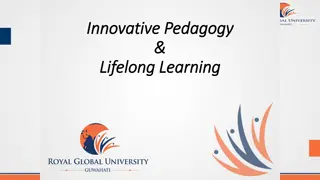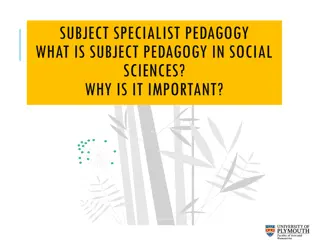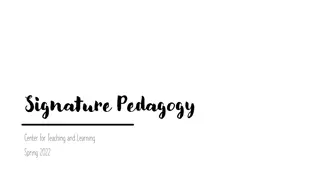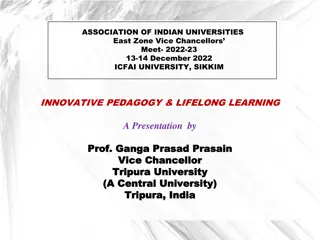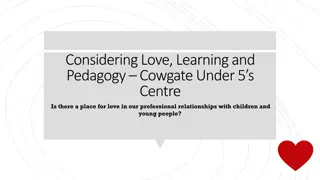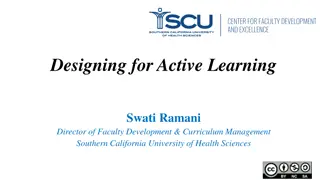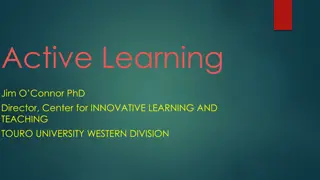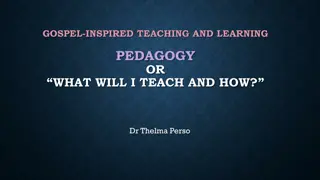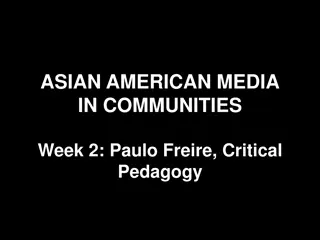Active Learning with Technology in E-Pedagogy Frameworks
Active learning is a hybrid teaching method that engages students in the learning process through meaningful activities, discussions, and group work. Embracing e-pedagogy frameworks can enhance student motivation, satisfaction, academic performance, and retention rates while fostering the development of transferable skills and closing attainment gaps.
Download Presentation

Please find below an Image/Link to download the presentation.
The content on the website is provided AS IS for your information and personal use only. It may not be sold, licensed, or shared on other websites without obtaining consent from the author.If you encounter any issues during the download, it is possible that the publisher has removed the file from their server.
You are allowed to download the files provided on this website for personal or commercial use, subject to the condition that they are used lawfully. All files are the property of their respective owners.
The content on the website is provided AS IS for your information and personal use only. It may not be sold, licensed, or shared on other websites without obtaining consent from the author.
E N D
Presentation Transcript
Active learning with technology exploring e-pedagogy frameworks Dr Vicki Dale, Senior Academic and Digital Development Adviser, University of Glasgow, vicki.dale@glasgow.ac.uk
What is active learning? A hybrid form of teaching in which class sessions include a combination of formal lecturing, collaborative group work by students, and discussions between student and lecturer. (Spaeth et al., 2017) Any instructional method that engages students in the learning process [it] requires students to do meaningful learning activities and think about what they are doing. (Prince, 2004, p.233, citing Bonwell and Eison 1991)
Why active learning... Engages students with lower motivation (Biggs, 2003) Increases student satisfaction (Carvalho, 2016) Enhances academic performance (Freeman et al., 2014; Hacisalihoglu et al., 2018; Hern ndez-de-Men ndez et al., 2019) Improves retention rates (Hern ndez-de-Men ndez et al., 2019) Leads to development of transferable skills/graduate attributes (Carvalho, 2016; Hern ndez-de-Men ndez et al., 2019) Closes the attainment gap between students (McNeil, 2019)
Approaches to e-learning Gonz lez (2012) identified 5 approaches to using a VLE: A. An information-focused strategy with the intention of providing easy access to course materials & administrative information B. An information-focused strategy with the intention of providing up-to- date/quality materials C. A communication-focused strategy with the intention of providing a space for asking questions, making announcements, keeping in touch D.A communication-focused strategy with the intention of engaging students in deep thinking through online discussions E. A collaborative-focused strategy with the intention of providing an online space for building knowledge
Activity Step 1. Examples of active learning with technology Can you think of different examples where we can use learning technologies to promote (active) learning? Discuss in your breakout rooms, and add individual examples to the Mural board: https://app.mural.co/t/uofgacademicservices6354/m/uofgacademics ervices6354/1668095164679/d4def5bd92f8fb3157ed1437f9a877ebd aec1ac2?sender=u10bfae3523a356d2be749625
3E framework (Smyth et al, no date) Enhance Extend Empower "Adopting technology in simple and effective ways to actively support students and increase their activity and self- responsibility" "Further use of technology that facilitates key aspects of students individual and collaborative learning and assessment through increasing their choice and control" "Developed use of technology that requires higher order individual and collaborative learning that reflects how knowledge is created and used in the professional environment" e.g. putting additional learning resources on Moodle for students to work through in their own time (~Gonzalez approaches A/B/C) e.g. asking students to work in pairs to create glossary entries in Moodle, or advance a critical conversation through use of forums (~Gonzalez approach D) e.g. students using MS Teams to evidence and showcase output of collaborative learning focused on an authentic task (~Gonzalez approach E)
Activity Step 2. Let's revisit those activities in terms of the 3E framework... Can you decide where in the 3E framework your examples of active learning with technology should go, in the Mural board? Does using this framework help you to identify additional examples of active learning? Please add them in Mural. Thoughts on the 3E framework?
Some other e-pedagogy frameworks Salmon's 5-step model Mayes' conceptualisation cycle (conceptualisation -> construction -> dialogue) Laurillard's conversational model (discussion -> adaptation -> interaction -> reflection) https://www.gillysalmon.com/five-stage-model.html Good overview of these by York St John University: https://tel.yorksj.ac.uk/epedagogy-models-frameworks/
Book: 100 ideas for active learning Includes a section on digitally enhanced learning, introduced by Vicki Dale, Richard Beggs and Ikedinachi Ogamba: https://openpress.sussex.ac.uk/ideasforacti velearning/part/digitally-enhanced- learning/ https://openpress.sussex.ac.uk/ideasforactivelearning/
References Betts, T., & Oprandi, P. (2022). 100 ideas for active learning. University of Sussex Library. https://openpress.sussex.ac.uk/ideasforactivelearning/ Biggs, J. B. (2003). Teaching for quality learning at university : what the student does (2nd ed. ed.). SRHE & Open University Press. Carvalho, A. (2016, 02//). The impact of PBL on transferable skills development in management education [Article]. Innovations in Education & Teaching International, 53(1), 35-47. https://doi.org/10.1080/14703297.2015.1020327 Freeman, S., Eddy, S. L., McDonough, M., Smith, M. K., Okoroafor, N., Jordt, H., & Wenderoth, M. P. (2014, June 10, 2014). Active learning increases student performance in science, engineering, and mathematics. Proceedings of the National Academy of Sciences, 111(23), 8410-8415. https://doi.org/10.1073/pnas.1319030111 Gonz lez, C. (2012, 2012/11/01). The relationship between approaches to teaching, approaches to e-teaching and perceptions of the teaching situation in relation to e-learning among higher education teachers. Instructional Science, 40(6), 975-998. https://doi.org/10.1007/s11251-011-9198-x Hacisalihoglu, G., Stephens, D., Johnson, L., & Edington, M. (2018). The use of an active learning approach in a SCALE-UP learning space improves academic performance in undergraduate General Biology. PLOS ONE, 13(5), e0197916. https://doi.org/10.1371/journal.pone.0197916 Hern ndez-de-Men ndez, M., Vallejo Guevara, A., Tud n Mart nez, J. C., Hern ndez Alc ntara, D., & Morales-Menendez, R. (2019, 2019/09/01). Active learning in engineering education. A review of fundamentals, best practices and experiences. International Journal on Interactive Design and Manufacturing (IJIDeM), 13(3), 909-922. https://doi.org/10.1007/s12008-019-00557-8 McNeil, J. (2019). Addressing barriers to student success: Scaling up active collaborative learning for student success. https://aclproject.org.uk/wp- content/uploads/2019/07/NTU-ABSS-final-report-Jan-21.pdf Prince, M. (2004). Does Active Learning Work? A Review of the Research. Journal of Engineering Education, 93(3), 223-231. https://doi.org/10.1002/j.2168- 9830.2004.tb00809.x Salmon, G. (n.d.) The Five Stage Model. http://www.gillysalmon.com/five-stage-model.html# Smyth, K., Bruce, S., Fotheringham, J., & Mainka, C. University benchmark for the use of technology in modules: 3E framework. Edinburgh Napier University. http://staff.napier.ac.uk/services/vice-principal-academic/academic/TEL/TechBenchmark/Pages/home.aspx Spaeth, D., Chan, A., Bohan, J., Fischbacher-Smith, M., Magennis, E., & O'Dell, K. (2017). Developing a Strategy for Supporting Active Learning Pedagogies: report of an LTDF-funded project. University of Glasgow.
